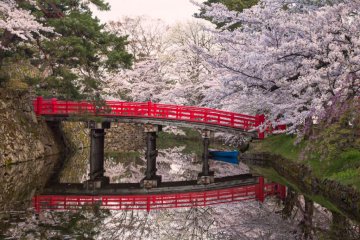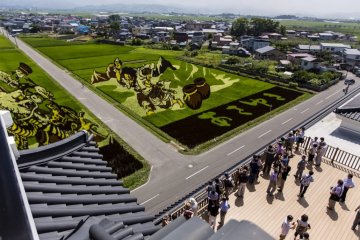
Le Château d’Hirosaki en rénovation
Justin VelgusLe Château d'Hirosaki dans la préfecture d'Aomori sera relocalisé en 2015 pour commercer le projet de rénovation prévu sur les murs du monument.

Le château d'Hirosaki est fermé pendant l'hiver du 24 novembre au 31 mars.
Le château de Hirosaki est un château japonais de style Hirayama construit en 1611. C'était le siège du clan Tsugaru, un clan féodal de 47 000un clan de 47 000 koku tozama daimyō, qui régnait sur le domaine d'Hirosaki dans la province de Mutsu, dans ce qui est aujourd'hui le centre d'Hirosaki à Aomori.
À l'origine, la tour du château était un bâtiment de 5 étages, mais après un coup de foudre, elle a brûlé jusqu'à ses murs de fondation. Une loi de l'époque stipulait que la tour ne pouvait pas être reconstruite dans sa forme d'origine. Elle a donc été reconstruite en une tour de trois étages, comme vous pouvez le voir aujourd'hui.
La tour d'Hirosaki est la seule tour du château de la région de Tohoku, qui a été reconstruite à l'époque d'Edo et est considérée comme un symbole de la ville d'Hirosaki.
C’est aujourd’hui une destination d'excursion intéressante, en particulier pendant la saison des cerisiers en fleur. Les premiers cerisiers du parc Hirosaki ont été plantés il y a environ 300 ans. Ici, les visiteurs ont également l'occasion d’admirer le paysage à bord d’un bateau ou encore d'admirer les illuminations du soir.

Le Château d'Hirosaki dans la préfecture d'Aomori sera relocalisé en 2015 pour commercer le projet de rénovation prévu sur les murs du monument.

La ville d'Hirosaki, située dans la préfecture d'Aomori, est célèbre et célébrée pour ses cerisiers en fleurs. Au printemps, un festival se déroule justement dans le parc attenant au château de la ville.

Inakadate in Aomori Prefecture is famous for its stunning and intricate rice paddy art. What began in 1993 with purple and yellow rice plants forming a picture of Mt. Iwaki has since grown into an annual event that draws in hundreds of thousands of visitors from around Japan and even internationally. The main purpose of the project was to show the tradition of manual work in the fields and in rice cultivation. This gave people a way to learn more about the dying art of rice farming and agriculture as society is fast-shifting toward a more urban lifestyle. Traditional rice farmers took advantage of the growing interest in rice art to make Inakadate a booming tourist center. In 2014, even the Emperor and Empress of Japan visited the site. At the beginning of June every year, guests can get their feet wet in the rice fields and learn how to plant the variants of rice to create that year’s picture. Then, later in the year at the end of September, it’s time to harvest that beautiful rice. If you decide to try your hand at planting or harvesting the rice, you’ll get a free lunch of onigiri and pork miso soup. Prior registration is required for either event and manual-labor clothing is expected.

Le festival Neputa à Hirosaki offre d'impressionnantes démonstrations de taiko et des défilés de chars lumineux au cours des soirées de la première semaine d'août.